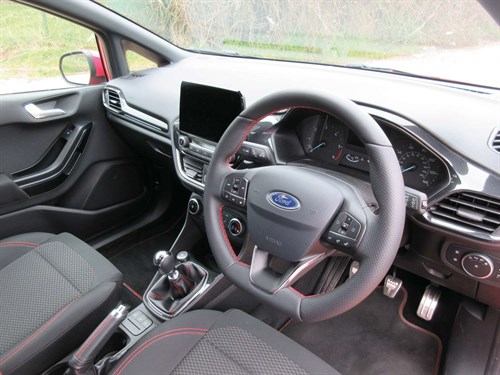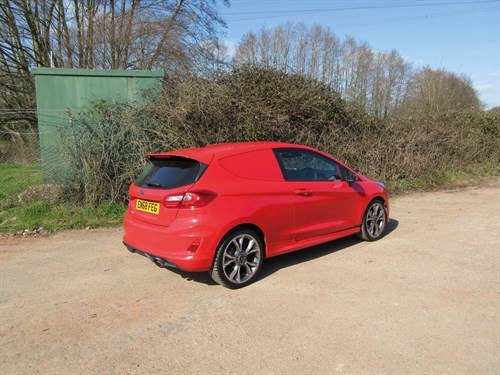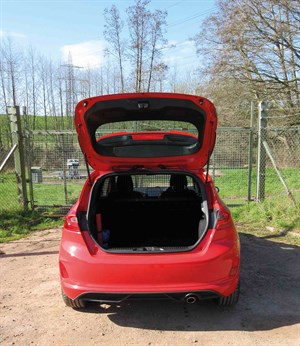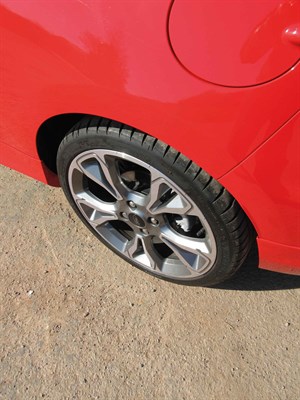Is there any significant demand for light commercial vehicles that are small hatchbacks?
UK market leader Ford seems to think so, despite the fact that every other manufacturer has exited the sector.
Vauxhall was the most recent to depart, axing the excellent Corsavan. Having abandoned the market itself sometime ago, Ford has returned – possibly prompted by Vauxhall’s departure – with a new version of the Fiesta Van.
Debuting at last year’s Commercial Vehicle Show, it comes with the choice of two specifications: entry level and Sport. The former can be ordered with a 85hp 1.1-litre petrol engine or a 85hp 1.5-litre TDCi diesel.
Opt for the Sport instead and you can choose either a 125hp 1.0-litre Ecoboost petrol engine or the 1.5-litre TDCi at 120hp.
We opted for the diesel Sport – and while we take the job of assessing light commercials with the utmost seriousness, we must admit that we looked forward to some fun.
As there are no longer any direct rivals to the Fiesta Van we have had no choice but to list compact panel vans as the key competition – one of which happens to be a Ford product.
Although its payload isn’t all that much better, the Transit Courier offers more load cube than Fiesta Van.
In diesel Sport guise it is several hundred pounds cheaper than the diesel Fiesta Sportvan, but offers less power. In the spirit of casting the comparison net as wide as possible, mention should also be made of the Piaggio Porter microvan.
It is still available, but solely in left-hand drive and in petrol, petrol and compressed natural gas, petrol and liquefied petroleum gas (LPG), and electric guises. It is not being marketed with a diesel engine.
 Load bay
Load bay
Access to the 0.96m3 load bay is via a single rear hatch, which has a heated rear window with a wash-wipe system.
The presence of glazing raises load area security concerns, so buyers may want to think about having a grille fitted to the inside of the window to deter thieves.
However, there is the risk that this will impair rearward vision – which is already affected by the full-height mesh grille attached to the top of the half-height steel bulkhead – and you might want to consider specifying reversing sensors as well.
A tailored rubber cover protects the cargo bed from minor scratches and scrapes while a mixture of plastic mouldings and carpet protects the sides.
Four load tie-down points should help you secure items that might otherwise slide about.

Interior and equipment
The Ford Fiesta Sportvan comes with a stylish body kit that includes distinctive body-coloured front and rear bumpers and side skirts plus a chrome exhaust extension. Our demonstrator came with a large body-coloured rear spoiler – an optional extra – with a high centre-mounted stop light.
Sport-style seats are installed in the cab, the pedals are stainless steel, the gear shift knob is aluminium with a leather gaiter, and the flat-bottomed steering wheel is leather-trimmed. Red stitching decorates the leather trim in both cases as well as the cloth seats.
Like the steering wheel, which plays host to the remote audio controls, the driver’s seat is height- and reach-adjustable. The cab is surprisingly spacious for the size of vehicle, with plenty of legroom, and the shape of the seats helps keep the occupants in place during vigorous cornering.
An optional Ford Sync 3 satnav and DAB radio package was installed. There’s also a tablet-inspired 8in touchscreen that sticks up from the dash, MP3-compatibility, Bluetooth connectivity and a USB socket.
Featuring AppLink, which enables smartphone apps to be accessed, Sync 3 can be integrated with Apple CarPlay and Android Auto. Voice commands can be used to control certain functions.
Emergency Assistance is installed so that help can be summoned promptly if there is an accident.
Our test van additionally boasted an optional FordPass Connect onboard modem. It allows a vehicle to be turned into a mobile Wi-Fi hotspot with connectivity for up to 10 Wi-Fi-enabled devices. Furthermore, it enables drivers to, among other things, remotely lock and unlock all the doors using the FordPass mobile app even when they are quite some distance away.
Aircon is part of the deal along with electric windows and electrically heated and adjustable exterior mirrors in body-coloured housings, a Quickclear heated windscreen, a 12V power point, and driver and passenger airbags.
In-cab storage features include a roomy but not lockable glovebox with an internal shelf, bins in each of the doors and a cubbyhole at the bottom of the dashboard. Three cupholders and a small tray are positioned on a console between the seats, and there is a sunglasses holder close to the courtesy lights above the windscreen.
Onboard electronic safety systems include ABS, electronic stability control, electronic brakeforce distribution, emergency brake assist, traction control (which can be switched off), hill-start assist and adjustable speed limiter. Also installed is a lane-keeping system that includes lane-keeping alert and lane-keeping aid.
The former causes the steering wheel to vibrate and a visual alert to appear on the dash if you unintentionally drift out of lane. The latter acts on the steering wheel to help guide you back into the correct lane if you fail to heed the warning. The technology deactivates automatically at speeds below 43mph (65km/h) or can be turned off manually.
Disc brakes are installed all round and front fog lamps should help you stay safe in misty conditions. Using MacPherson struts at the front and a torsion bar at the back, the suspension has been tweaked for sharper handling.
Our van sat on optional 18in Rock Metallic machined alloy wheels shod with Michelin Pilot Sport 4 205/40 R18 tyres. A pressure monitoring system keeps an eye on them and alerts the driver if there is a problem. There has to be some concern as to how long such low-profile tyres will last on a vehicle that is used as a working tool. However, they undoubtedly enhance its handling and grip.
Electric power-assisted steering delivers a 10m turning circle kerb to kerb, expanding to 10.4m wall to wall.
LED daytime running lights are fitted and are normally paired with halogen projector headlamps. However, our van was equipped with optional LED headlights and rear lights.
 Driving
Driving
There’s no denying that the Sportvan is huge fun to drive. It corners as if on rails, with next to zero body roll and ample feedback through the steering. The response is instant. Nor do we have any quibbles about the performance, which is hardly surprising with 120hp on tap in such a small van. Acceleration from rest is strong and continues to be so as you go up through the gears. The gear-change is Swiss-watch precise, requiring the minimum of effort.
Drawbacks? With low-profile tyres and a stiff suspension the ride is never going to be all that smooth, and the driver has to put up with rather too much tyre noise. Other sources of noise are muted though, and the build quality is worthy of applause.
So is the satnav. The mapping and the accompanying visual instructions are clear, as are the verbal directions. Tire of them, and you can always switch them off.
Engine and gearbox
Fitted with a variable-geometry turbocharger and a cast aluminium cylinder head and block, the Sport Van’s high-pressure common-rail direct-injection diesel generates maximum power at 3,600rpm.
Top torque of 270Nm bites across a 1,750-2,500rpm plateau.
The four-cylinder in-line eight-valve transverse-mounted engine is married to a six-speed manual gearbox.
A push-button starter is fitted but the key fob has to be present for it to work.
You might want to keep the fob in a metal-lined Faraday pouch to ensure thieves do not steal its code and use it to start your vehicle.

Operating
The Sportvan is covered by a three-year/60,000-mile warranty with roadside assistance provided for the first year on an unlimited-mileage basis. Nor is there a mileage limit on the year-long paint warranty.
The package is not overly generous, but redeems itself somewhat with a 12-year/unlimited-mileage anti-perforation corrosion warranty. Service intervals are set at one-year/10,000 miles, which is on the short side for a modern diesel LCV.
The official combined fuel economy figure is 64.2mpg.
At 54.7mpg, according to the onboard computer, we averaged significantly less, travelling lightly laden along a mix of motorways, A- and B-roads and including a crawl around Bristol city centre. We did it all on a still, dry, warm day.
A gearshift indicator light encourages you to change to the most economical gear and stop/start (which can be switched off) helps fuel efficiency too, especially in urban areas.
Smart regenerative charging ensures that the battery is only recharged when it needs it, saving energy again.
There is another way in which the Fiesta Van can help cut diesel usage: Press the ‘EcoSelect’ button and you reduce peak power and torque, thereby reducing diesel consumption further.
We found that using it diminishes on-the-road performance by an estimated 5% to 10%, which should be liveable with in most cases.
In addition, the Active Grille Shutter keeps a shutter open to cool the engine at low speeds, but closes it at higher speeds.
That makes the vehicle more aerodynamic, thus saving fuel. A steel spare wheel is provided and the Ford Fiesta Van is also equipped with an EasyFuel cap-less refuelling system.
Ford Fiesta Sportvan 1.5TDCi 120hp
Price (ex VAT) £16,495
Price range (ex VAT) £13,245-£16,495
Gross payload 511kg
Load length 1,283mm
Load width (min/max) 984/1,281mm
Load bay height 923mm
Load volume 0.96m3
Loading height 724mm
Rear door aperture 948 x 613mm
Gross vehicle weight 1,665kg
Braked trailer towing weight 1,100kg
Residual value 21.3%
Cost per mile 34.7p
Engine size/power 1499cc, 120hp @ 3,600rpm
Torque 270Nm @ 1,750-2,500rpm
Gearbox 6-spd
Fuel economy 64.2mpg
Fuel tank 40 litres
CO2 111g/km
Warranty 3yrs/60,000mls
Service intervals 1yr/10,000mls
Insurance group 29E
Price as tested £18,355
* after 4yrs/80,000mls; Source: KwikCarcost
Options fitted
Race Red paint finish £150
18in Rock Metallic machined alloys with 205/40R18 tyres £400
Large rear spoiler £150
FordPass Connect modem £210
Ford Sync 3 package £400
LED headlights and rear lights £550
Rivals
Fiat Fiorino Cargo
Price (ex VAT) £12,595-£15,495
Load volume 2.5m3
Gross payload 610-660kg
Engines 75hp 1.4 petrol, 80hp, 95hp 1.3 diesel
Verdict: Compact and fuel-efficient with a high degree of manoeuvrability, the Fiorino Cargo is tailor-made for Britain’s urban streets. It’s no slouch in the countryside either, with the Adventure guaranteed to keep you rolling in moderately slippery conditions thanks to mods such as a raised suspension and the Traction+ electronic diff lock.
Ford Transit Courier
Price (ex VAT) £12,695-£15,970
Load volume 2.3m3
Gross payload 534-600kg
Engines 100hp 1.0 petrol, 75hp,100hp 1.5 diesel
Verdict: The fact we are putting up another Ford product as a rival to the Fiesta Van serves only to underline the lack of choice in this sector of the market. Not that this should be taken as a criticism of the Transit Courier. What Van?’s Small Van of the Year for 2019 offers impressive handling, a decent ride, a precise gear change and respectable fuel economy.
Mercedes-Benz Citan
Price (ex VAT)£15,400
Load volume 2.4m3
Gross payload 370kg
Engines 90hp 1.5 diesel
Verdict: While the Mercedes-Benz Citan is a close cousin of Renault’s Kangoo, the Kangoo line-up no longer contains a model as small as the Compact. The load cube is respectable for a light commercial of its size, but the payload capacity is modest, and Renault dropped the Kangoo equivalent because it found there was insufficient demand.
The Final Verdict
|
Design |
8/10 |
Styling kit and alloy wheels make it stand out in the high street. |
|
Cabin |
8/10 |
Comfortable and roomier than you might expect. |
|
Ride |
6/10 |
Firm, and you feel all those potholes. |
|
Refinement |
7/10 |
To a decent standard apart from the tyre noise. |
|
Load area |
7/10 |
Not a van you buy for cargo space or payload capacity. |
|
Handling/performance |
9/10 |
Hugely impressive on both fronts. |
|
Engine/transmission |
9/10 |
Well-matched, with the gearbox delivering a precise change. |
|
Standard equipment |
8/10 |
Plenty of kit, but might need reversing sensors. |
|
Operating costs |
7/10 |
Warranty and service intervals could be more generous. |
|
What Van? subjective rating |
8/10 |
More practical vans are around, but few offer quite so much fun. |

 Load bay
Load bay Driving
Driving



